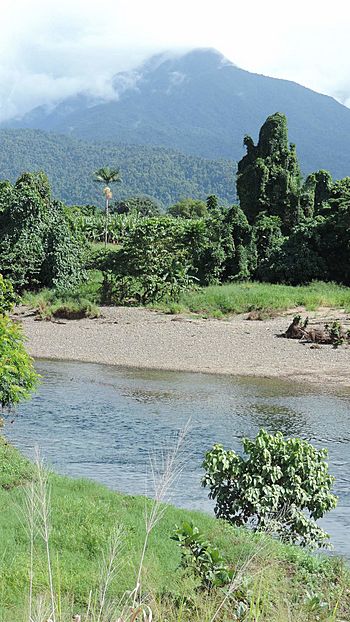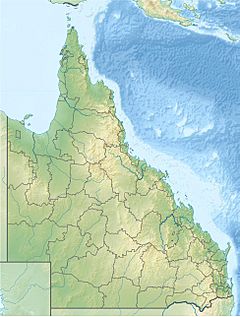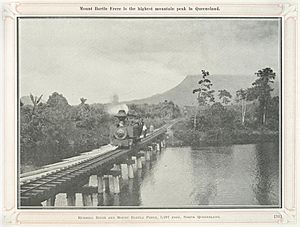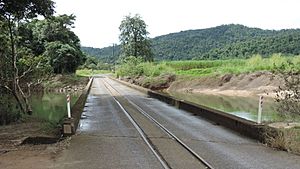Russell River (Queensland) facts for kids
Quick facts for kids Russell |
|
|---|---|

Russell River, between Woopen Creek (foreground) and Bartle Frere (background), 2018
|
|
|
Location of Russell River river mouth in Queensland
|
|
| Country | Australia |
| State | Queensland |
| Region | Far North Queensland |
| Physical characteristics | |
| Main source | Bellenden Ker Range east of Topaz 206 m (676 ft) 17°23′32″S 145°44′36″E / 17.39222°S 145.74333°E |
| River mouth | confluence with the Mulgrave River west of Russell Heads 0 m (0 ft) 17°13′49″S 145°57′06″E / 17.23028°S 145.95167°E |
| Length | 59 km (37 mi) |
| Basin features | |
| River system | Mulgrave River catchment |
| Basin size | 669 km2 (258 sq mi) |
| Tributaries |
|
| National parks | Wooroonooran National Park; Russell River National Park |
The Russell River is a river found in Far North Queensland, Australia. It is about 59-kilometre (37 mi) long. The river flows towards the Coral Sea, which is part of the Pacific Ocean. You can find it about 60 kilometres (37 mi) south of a city called Cairns.
Contents
Where the River Starts and Flows
The Russell River begins in the Wooroonooran National Park. Its water comes from the Bellenden Ker Range, near tall mountains like Mount Bartle Frere and Mount Bellenden Ker.
At first, the river winds and turns a lot as it flows southeast. It then leaves the Wooroonooran National Park. Later, it flows northeast and is joined by Josephine Creek. The river also passes by the beautiful Josephine Falls.
The Russell River flows east of Babinda and then heads north. On both sides of the river, you'll find the Russell River National Park.
Joining Another River
The Russell River eventually meets the Mulgrave River. This meeting point is called a confluence. Here, the water becomes a mix of fresh river water and salty ocean water. This area is known as an estuary.
The Mulgrave River then flows a short distance east. It empties into the Coral Sea through a place called Mutchero Inlet.
River Uses and Size
Farmers use water from the Russell River to grow sugar cane. This happens on the flat coastal lands near the river's end.
The area of land that drains into the Russell River is called its drainage basin or catchment area. This area is about 669 square kilometres (258 sq mi). About 68.8 square kilometres (26.6 sq mi) of this area is wetlands, which are like marshy or swampy lands.
From its start to its end, the river drops about 206 metres (676 ft) in height. This happens over its 59-kilometre (37 mi) journey.
Fun Activities and History
The Russell River is a popular spot for whitewater rafting. People enjoy riding rafts through its fast-moving sections.
Like the Mulgrave River, the Russell River has a history of floods. Records show that floods have happened since the late 1930s.




